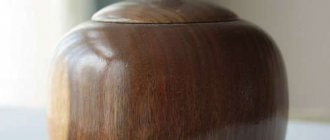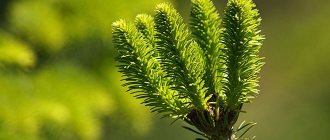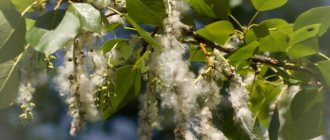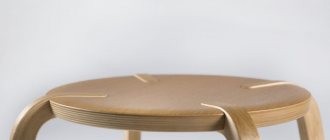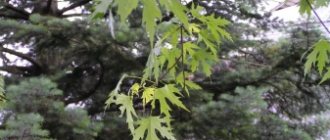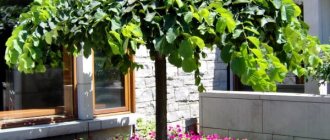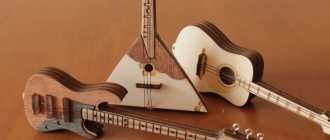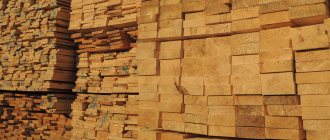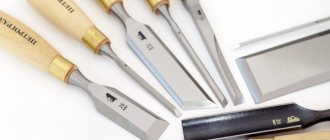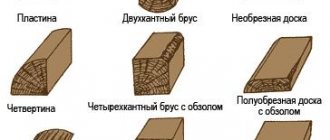Spruce is a plant that is actively used for decorating personal and garden plots and territories. The popularity of Christmas trees is explained by their excellent decorative qualities. Thanks to this, the plant can be easily used in the most complex design projects. The variety of types and varieties of Christmas trees allows you to easily select the most suitable variety for a particular site, depending on the area and specific requirements. And due to the high frost resistance of spruce, it can be safely grown even in the northern regions of Russia.
Varieties of fir trees
Spruce (bot. Picea) includes more than 4 dozen species that in their natural environment prefer cold or temperate climatic conditions. The soil should be sandy, rocky, some species grow in marshy areas.
The trees do not require special care: they are drought-resistant and generally tolerate frost easily. There are also varieties that are not afraid of waterlogged soil and environmental gas pollution.
Norway spruce (Picea abies)
This plant is characterized by its large size - its height reaches 50 m. It grows by 0.5 m annually, and its girth in width increases by 15 cm. It grows slowly over 1-1.5 decades, and then this process accelerates. The crown has the shape of a pyramid, and the apex is pointed. The ends of the branches are raised, but at the same time look to the side. The color of the needles is juicy green. The needles are glossy, have a tetrahedral shape, the length does not exceed 2.5 cm. The cones are oblong with a length of 10 to 16 cm and a thickness of 3-4 cm.
The most famous varieties of common spruce:
- Acrocona
- Ohlendorffii
- Frohburg.
In Russia, it is most common in the European part of the country; even in the Urals you can find common spruce. There are no difficulties in care. The age of the culture in natural conditions can be 250-300 years.
Serbian spruce (Picea omorika)
A tall plant whose shape resembles a narrowed cone or column, the top of which is pointed. The needles are glossy and dark green. On the reverse side of the needles there are two silvery-white lines. The cones are not large in size, and their color is bluish-black.
In nature, the tree grows in mountainous areas. In the city, it is unpretentious to the type of soil and is not afraid of air pollution. Sotra of this variety of conifers: Nana, Peve Tijn.
Canadian or gray spruce (Picea glauca)
This type of Christmas tree grows up to 25-30 m, and the trunk diameter is 60-120 m. When grown within the city or used as a garden design, its height will not exceed 15 m. Its homeland is North America.
The foliage is dense; the main branches of young crops are raised, while those of adults are lowered. The cones are small in size: the length does not exceed 7 cm, and the thickness is 1.5-1.5 cm. They are colored light green, and after ripening they change color to brown. The needles are bluish-green and thick.
Canadian spruce varieties: Alberta Globe, Conica, Sanders Blue
Engelmann spruce or weeping spruce (Picea engelmanii)
This type of coniferous crop is native to North America, where it grows in the depleted soil of the rocky mountains. The height of the tree reaches 50 m. The shape of the spruce resembles a cone with wide foliage, the branches are sloping, and there are needles on them. Their color varies depending on the location: on the growths they are bluish-green, and at the base they are dark. The cones are conical and small in size. Their maximum length is 7 cm. They are burgundy in color.
This variety is not afraid of urban conditions and various influences of climate and soil. This type of Christmas tree tolerates winter well, is not afraid of drought and shady areas, so it can be used to decorate a garden plot.
Weeping conifer varieties: Bush's Lace, Snake.
Prickly or blue spruce (Picea pungens)
The well-known species, distinguished by its beauty and resistance to sub-zero temperatures, adapts well to the conditions of a metropolis with its polluted air. In the wild, it grows in the mountains of North America; it can reach a height of 30-40 m, and the trunk diameter is about 1.5 m. The crown is well developed and resembles a wide pyramid. The branches take a horizontal position, and the ends are slightly raised.
Young roots are bare and easy to spot by their bright brown color. The needles are gray, but as the tree grows, they become green. The cones grow up to 11 cm, and their width is 2 cm (closed) or 4 cm (open).
Attention!
Blue spruce is rightfully considered one of the hardiest. It is second only to Picea abies in its ability to tolerate shady areas normally.
Varieties of blue spruce (Hermann Naue, The Blues, Hoopsii) normally take root in any type of soil, are not afraid of environmental pollution, and survive drought and severe frosts well.
Black spruce (Picea mariana)
The crop is large, the green mass of which has the shape of a pyramid. Under natural conditions it grows up to 20-30 m. When grown in a populated area or used as a decoration for a garden, the height is no more than 3 m. The needles are short, but thick, their color is bluish-green. The branches of the tree are covered with red pubescence.
There are only 7 varieties of black fir trees, among which the most famous are Nana and Aurea. All these conifers are unpretentious in care and resistant to frost.
Siberian spruce (Picea obovata)
Another variety of common spruce is Siberian. This tree has narrow, cone-shaped foliage. The branches begin to grow from the ground. The shoots are colored light brown and have slight pubescence. The needles are dark green, sharp, glossy, their length does not exceed 3 cm.
Many properties make it similar to European spruce, but development is slow. Maximum height 35 m. Grows in forests and mountainous regions of Siberia, China, Mongolia and northern regions of Europe.
This breed is one of the most resistant, so it will take root in any conditions. The most common variety is Glauka (Var. glauca)
Eastern spruce (Picea orientalis)
You can often find it in the mountains of the Caucasus and Turkey. The plant is large, and its height reaches 60 m. The crown is dense, develops symmetrically, and resembles a pyramid. The branches are raised at their base and sloping at the ends. The growth in height per year is no more than 20 cm.
Attention!
When choosing this species, it is worth considering that young plants develop much slower than adults.
The needles are green, hard and small. The size of the cones varies from 6 to 8 cm, their shape is oblong and narrowed. The color is dominated by red and purple shades. When growing, it is worth remembering that it takes root well on light types of soil, and if there are severe frosts in winter, the tree will freeze. Representatives of the species Nutans, Aureospicata.
Spruce mariorika (Picea x mariorika)
This breed was bred by breeders in Germany at the beginning of the last century. It was obtained by crossing black and Serbian spruces. Later, biologists developed even more interesting and unusual varieties.
Picea x mariorika is a large tree, reaching a height of 30 m, the crown is wide in the form of a pyramid. On horizontally located branches there are needles, colored bluish-green. It is not difficult to distinguish the Christmas tree from other relatives: on the reverse side it has silver stripes. The cones grow no more than 5 cm and are represented by the Machala variety.
Iezskaya or Ayanskaya spruce (Picea jezoensis)
A representative of conifers, which in wild conditions can grow up to 30-50 m. When grown as an ornamental plant, its height is no more than 10 m. Such indicators are typical for trees no younger than 30 years old. Ayan spruce grows near river banks, tolerates frost well, and can fully develop in the shade.
The shape of the crown resembles a pyramid. The needles are flat, 1.5-2 cm long, dark green, with blue or white stripes below. The cones are oval and oblong, their length does not exceed 8 cm. A striking representative of the species is Nana Kalous.
Red spruce
The height of the tree is 20-40 m, however, in unfavorable natural conditions, the figure can drop to 4 m. The crown has the shape of a cone with a noticeably wide base.
The needles are quite long and reach 15 mm, practically not prickly due to the roundness at the end. This variety is typical for Canada, England, and the mountains of Scotland.
Healing properties of wood
It is known that all types of Christmas trees, without exception, are not only ornamental crops in garden plots, but also bring benefits. Everyone has known about this for a long time. In matters of healing properties, the common spruce turned out to be the leader.
Needles, shoots and even cones are useful, but they are young. They contain a lot of essential oils, tannins, resins, vitamins, microelements, and fatty oils.
Thanks to preparations based on pine needles and decoctions, it is possible to relieve inflammation in the respiratory and genitourinary systems, sinusitis and other diseases of the nasopharynx. For skin problems, gout and arthritis, baths from the buds and branches of the plant will help.
You can brew tea from fresh buds and consume it - it is rich in vitamins. The simplest recipe:
- Grind 40 g of pine needles;
- pour 1 tbsp. boiling water;
- cook for 20 minutes, then let it brew.
Use the resulting decoction throughout the day if you have a vitamin C deficiency.
Attention!
This drink should not be consumed by patients with stomach ulcers.
The needles contain phosphorus, potassium, iron and vitamins. Ascorbic acid and carotene are also present in large quantities, so pine needles serve as raw materials for creating pastes intended as a preventive measure against scurvy and periodontal disease.
Camphor is made from essential oil, which is necessary for the treatment of heart diseases. It also helps get rid of inflammation of the bronchi and mucous membrane of the throat.
Application
Energy properties. Spruce gives off energy, but if a person rarely visits spruce forests, then the tree can have a depressing effect on his psyche. Brief contact with spruce helps eliminate overstrain, nervousness, and teaches you to enjoy solitude, using it as a time for self-improvement.
Use in landscape design
Decorative by the shape of the crown, the color of the needles and cones. Decorative durability up to 50-55 years.
It is an important component of park and forest compositions
Single plantings, groups, alleys, arrays, hedges.
Medicinal use
Spruce has an anti-inflammatory and breathing-easing effect. Preparations made from spruce save against scurvy, stimulate the immune system, and help restore tissue after bruises, abrasions, and wounds.
Collection and processing of medicinal raw materials
Application in official and folk medicine
In folk medicine, spruce bark, pine needles and cones are used. Bark and needles are collected in the summer. The cones are collected before the seeds begin to ripen.
Features of landscape design
Landscape designers use all types of spruce in their work. But their use depends on the type and variety.
Before planting a tree, you need to consider the following:
- Christmas trees with dove or blue needles will set off the green lawn;
- tall plants are not suitable for small areas. But on an area of 12 acres or more, they will help to beautifully frame the facade of a house or build an alley;
- any garden can be diversified by planting low-growing Christmas trees in a group;
- conifers and rhododendron cannot be neighbors;
- low-growing and dwarf Christmas trees are suitable for any territory and will be appropriate there;
- if you plant dwarf Christmas trees next to flowers, the composition will look impressive.
Attention!
Trees have shallow roots, so other crops must be planted at least 2 m away from them.
- You can supplement the pine needles with decorative bushes, but not with a red crown;
- dwarf Christmas trees are well complemented by daffodils, tulips and scillas;
- You can use representatives of conifers to create a hedge.
In addition, landscape designers note some advantages of planting a Christmas tree on any site. Here we are talking about decorativeness, regardless of the season. Also, culture will fit into any design and the design style is not important. In addition, planting spruce purifies the air and has a positive effect on health.
Growing Norway spruce
Decorative forms and varieties of Norway spruce prefer fresh, well-drained, acidic sandy and loamy soils. It also tolerates neutral and highly alkaline soils. But they do not tolerate both dry soil and excessive waterlogging.
When planting, it is necessary to make a drainage layer 15–20 cm thick. It is important that the root collar remains at ground level when planting.
Only some dwarf varieties require shelter for the winter. For example, Little Gem, which does not tolerate snow caking on the crown. It is optimal to install a frame around the plant in winter, which will reduce the snow load and create an air cavity. In the first years, you need to do the same with the Procumbens variety.
Planting a plant
Christmas trees, regardless of breed, do not require special care. But despite this, in order for them to grow and develop fully, some rules still need to be followed.
First of all, it is important to choose the right seedlings. You can grow a tree from seeds, but this procedure is lengthy and requires a lot of labor. Selected seedlings must be at least 0.7 m tall, with the exception of dwarf Christmas trees. If you decide to plant tall crops, then you need to take them no more than 3 m. The roots of young plants must be closed, otherwise they can be easily damaged during transportation, as a result of which they will not take root.
In order for conifers to develop lush foliage, they need soil with a high content of humus and a low groundwater level. There are no more land requirements for planting a Christmas tree.
For the first planting of seedlings you need to prepare the soil mixture:
- turf – 30%
- peat – 30%;
- sand – 20%;
- humus – 20%;
- nitroammophoska – 150 g.
Thanks to this composition, the tree receives the necessary nutritional components.
Attention!
It is better to plant plants in autumn or spring. You need to choose the moment when flowering has not yet begun or the stage of active growth has already passed.
The landing is done like this:
- Choose a place where the Christmas tree will grow. The site should be sunny and open. If planted in the shade, the tree will become bare and lose its decorative effect.
- Prepare the soil.
- Dig a hole 0.7-0.8 m deep and 0.5-0.6 m in diameter.
- Place drainage at the bottom of the hole. Its role can be played by crushed stone, the thickness of which is 10-15 cm.
- Cover it completely with soil.
- Pour water over a bucket and wait until it dries completely.
- Plant a seedling in the center.
- The voids that appeared after watering should be filled with soil and compacted.
- Mulch the soil with peat.
Mulching is a process through which moisture evaporates more slowly and saturates the soil with nutrients.
Reproduction
How and in what way a spruce tree can be grown is probably of interest to any gardener. There are several ways to propagate this wonderful tree and save a decent amount of money. The most common ways are:
Reproduction by layering is the simplest and most effective method. The branch of the lower tier of the spruce tree is dug into the soil and watered regularly. After about a year, the branch will have its own root system. This allows it to be separated from the mother branch and planted separately.
The generative method involves sowing spruce seeds in separate boxes. The seeds are pre-soaked for 24 hours and then planted in a container, which is subsequently tightly covered with film. The first shoots appear after a month of planting. The disadvantage of this method is that the original properties of the mother tree are not guaranteed.
To preserve all the properties of the mother tree, the cutting method is used. A small cutting is cut from a tree to be propagated that has reached 5 years of age.
Planting is done in a separate container with soil. After watering, the container is covered with film and placed in a warm place. Rooting of the cutting occurs within a year, after which it is planted in open ground.
Rules of care
After planting a spruce seedling, you need to properly care for it. This is the only way to achieve a beautiful and healthy tree. You just need to take into account the needs of the plant. But the conifer family is easy to care for, so you won’t need to put in much effort.
Watering
An important condition for the full development of the Christmas tree is proper soil moisture, especially after the first planting. Drying out is also detrimental as the plant will die. You need to water constantly. For example, in summer it is important to carry out the procedure at least once a week. Pour a bucket of water under each new bush.
For the procedure, the liquid must be at room temperature. This approach will allow you to clean the needles from dirt and improve the biological processes in the plant.
An adult crop can survive without watering for 14 days. The exception to this rule is extreme heat. Blue spruces tolerate moisture deficiency well.
Top dressing
There is no need to fertilize the tree. In addition, you should not overuse fertilizing. But if you still need to use fertilizers, then you need to choose special types that were created specifically for pine needles. The drugs must be diluted strictly following the instructions, without exceeding the dosage.
Interesting Facts
Spruce wood is excellent for making musical instruments. Stradivarius and Amati instruments were made from it;
- Because of the thick needles, the spruce forest is always dark and shadowy. Even in hot sunny weather it is quite cool there;
- Young spruce trees often grow from the root system of a dead tree. In Sweden there are spruce roots that are more than nine and a half thousand years old;
- Some European peoples considered the Christmas tree a totem plant: before battles, ancient German warriors decorated the tree with beautiful flowers and cast special spells on it to appease the spirits;
In addition, it is worth noting that this tree has healing properties. Its parts contain a huge amount of useful substances, so its needles and wood are often and successfully used in a variety of fields.
